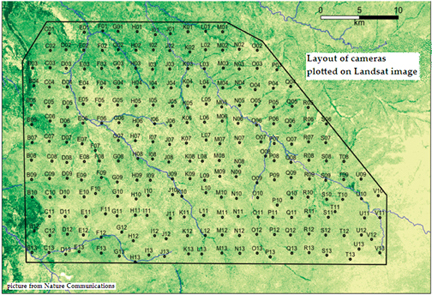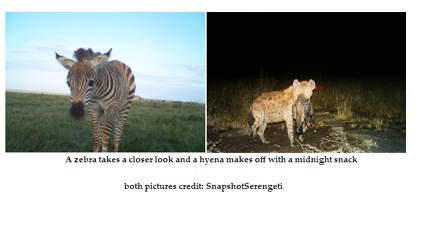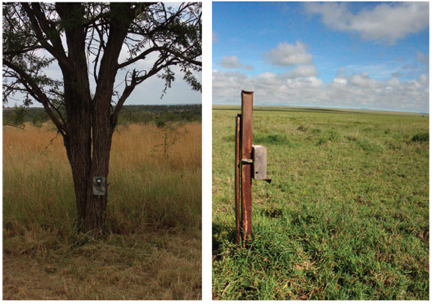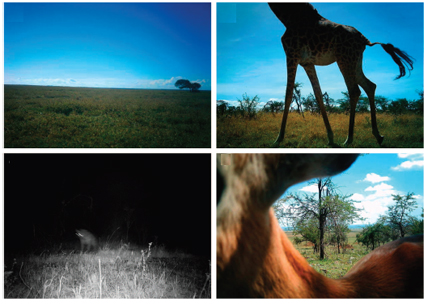Candid camera spies on nature
The concealed camera is giving us a whole new view of wild-life, says S.Ananthanarayanan.
Observing animals in the truly wild presents many challenges. It is nearly impossible at night and even in the day animals do not wait to be observed. Sightings, except for rare closeups, thus need to be from a distance
and we know very little about how animals behave when they are really alone. For the same reason, we do not even know all the kinds of animals there are in an area, nor even nearly correct numbers of many of them.
Alexandra Swanson, Margaret Kosmala1, Chris Lintott, Robert Simpson, Arfon Smithand Craig Packer, from the universities of Minnesota, Harvard, Oxford and the Adler Planetarium at Chicago describe in the journal Scientific
Data, a trial with 225 concealed cameras, in the Serengeti National Park, Tanzania, over a period of four years. The results of the trial are the first of their kind in terms of the discretion of observation, the quality, the statistical importance and also
the quantity of information collected.
We could say that first to systematically catch animals unawares were the trappers. They set traps, concealed pits, nets or clamps that closed when an animal stepped on them, and the purpose was to physically capture
the animals, usually for their fur. Now, the idea of the trap has been turned over, using cameras instead of nets or clamps, to capture images of animals while they move in the forest, undisturbed and unaware, and continuously, for months on end. The way the
camera trap is sprung is either by a sensor of heat or movement, or both, and the camera takes a series of pictures, hopefully to capture images of an animal, a group of animals, animals with their young, a predator, an animal in flight, and so on.
Camera traps have been in use for some twenty years, the Scientific Data paper says, generally to document rare species in understudied areas or to estimate numbers of species whose individuals could be identified.
The second use of camera traps is in fact something like the tracking that is done by fixing a metal or radio tag on an animal or even DNA analysis of droppings, etc. But, with the advances in high resolution, automatic cameras as well as the computer processing
of images, it is now possible to carry out more intensive surveys, of multiple ‘unmarked’ species, the paper says.
Snapshot Serengeti
Snapshot Serengeti, as the survey was called, stationed 225 cameras in a 1,125 square km grid within the protected National Park that lies in the 25,000 square km Savannah ecosystem straddling the Kenya-Tanzania border
in East Africa. The region has large numbers of the wildebeest and zebra, which migrate along with the seasonal rains to the plains. There are also great many other species and the present survey was to understand where and when predators and their prey moved
in the forest, and and to add to an on-going survey of the lion population since 1960 and also surveys of the herbivore population, the paper says.The camera-trap grid spanned a rainfall and vegetation gradient, which would create a direction of movement and
was arranged so that it covered the whole area being studied, with at least two cameras to cover the home range of each major animal species.

The arrangement was first set up in Nov 2010 and has been working continuously since Feb 2011. By the year 2013, each of camera had been in action for 440 days and a total of 1.2 million image sets, each set consisting
of one to three pictures taken together, were created. The cameras were distributed, as shown in the picture, each within a five square km cell, so that they covered the whole trial area. The cameras were mounted, within steel cages, on conveniently located
trees, or posts, and 50 cm from the ground, to get pictures of large animals. The grass was trimmed to less than 30 cm and branches were also trimmed to avoid obstruction or false firing of cameras.

The cameras fired at night mostly with a normal flash, rather than an Infra Red flash, which had been used at first, as the latter was found to yield poor images. But the sensor, which set off the camera, was an IR
sensor, which responded to body heat of the animal, and there were sensors that responded to movement. At first, the sensors were set to ‘high’ sensitivity, but this produced much false triggering, and the setting was fixed at ‘low’. Each time the camera was
triggered, the IR flash cameras took three pictures, but the others took only one picture, as the flash consumes more power. There was also a delay of one minute built in between picture events, to prevent continuous operation if there was a herd of animals!
Dealing with 1.2 million picture sets presents a huge challenge. The pictures were first technically sorted by computers, but further inspection and classification had to be by humans. The pictures were loaded on a
website of Zooniverse, the ‘citizen science’ platform, and the work of dealing with the million-odd pictures was carried out by 28,000 volunteers who came from the general public. Novice participants who registered for the task on the website were given guidelines
for identifying 48 possible species and the software provided for simultaneous and successive viewing of sets of pictures. There was also a faster track for knowledgeable participants. 322,653 pictures were identified as those of of the 48 species of animals,
including rare species like the aardwolf and the zorilla.
 credit:SnapshotSengeti
credit:SnapshotSengeti
Each picture was also inspected by many viewers and the findings were analysed on computer, to discard identification that was not ratified by others. And finally, a sample of a little over 4,000 pictures was viewed
by a panel of ‘experts’ and the results were used to validate the finding of the citizen viewers. As many as 96.6% of the pictures were found to have been correctly identified.
 credit:SnapshotSengeti
credit:SnapshotSengeti
The data collected represents an unprecedented set of observation of animals, both from the viewpoint that the animals suspected no outsider, like a cameraman, as well as of the number of close pictures of animals in
action. Apart from obvious value for the study of wild-life, the authors of the paper point out that the method of data acquisition is also without precedent. “The consensus classifications and raw imagery provide an unparalleled opportunity to investigate
multi-species dynamics in an intact ecosystem…….We anticipate broad interdisciplinary re-use of these data sets with applications that span basic and applied ecology, citizen-science research, machine learning, and computer vision,” they say in the paper
[the writer can be contacted at simplescience@gmail.com].
More pics at the link